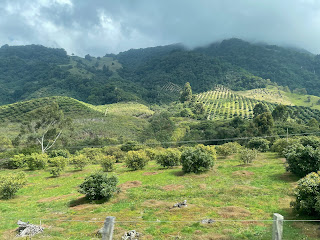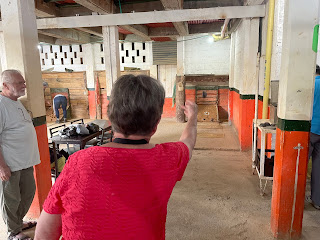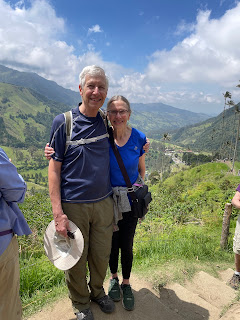This morning we drove by bus for a couple hours to reach the village of Salento. Along the way, we passed another burned out and destroyed mansion of a former drug lord. In this case, the local population had vandalized the building, looking for hidden drug money or other treasures after the drug lord's demise.
Jesús Martín, the coffee plantation farmer we visited yesterday, has his roasting facility near here. He is unusual, because most coffee growers in the region simply bring their dried coffee beans to a central market and sell them to a broker who roasts, packages, and exports them.
Jesús Martín, on the other hand, processes his beans completely, and sells both the beans and brewed coffee to customers inside Colombia, as well as exporting them. The roasting operation is surprisingly small, but uses state-of-the-art equipment imported from Germany, and a trained coffee taster to run the operation.
Carlos, the taster, demonstrated for us by roasting a small batch of medium roast coffee as we watched. He monitors temperature and pressure continuously, and has a way to pull out a small number of beans frequently to check their color, and then to return them to the batch. Near the end of the roasting, he was checking color about once every 20-30 seconds to get it just right.
After the roasting is complete, the beans must be cooled quickly and uniformly, so attached to the roaster is a machine that stirs the batch over a screen through which cool air is blown. Only 20-24 pounds of coffee can be roasted in each batch, so in peak seasons Carlos must run 25-20 batches per day. In those times, he has only two or three additional employees to assist him.
We drove on through beautiful hill country, with the Andes in the background, to Corcora National Park. In these hills grow an endangered species of palm tree that grows at high altitude. We climbed from 8000 to 8500 feet elevation among these very tall trees. Views were spectacular!
After the hike, we went to lunch at a very charming indoor/outdoor restaurant. Because the climate here is so mild, many buildings are roofed areas with only two or three walls. The rest is open to the fresh air. Most of the group selected trout from the menu choices, and it was quite good.
After lunch, we finally made it to Salento. This is a special little town because so much traditional architecture has been preserved here. While many towns have taken down traditional buildings -- or have lost them to earthquakes -- replacing them with brick and concrete structures, Salento has blocks and blocks of traditional homes and storefronts.
One of those storefronts is a Jesús Martín coffee shop. Here, one of the baristos demonstrated for us some "latte art," the decorative patterns made in the foam tops of espresso drinks. These aren't simple heart shapes as we often see in U.S. coffee shops.
He made various animals and designs. Then he instructed us in how to make designs in our own drinks. They turned out better than we might have imagined, but not as artistic as his work.
After enjoying our cappuccinos or mochaccinos, many in the group bought little bags of coffee to take home. But these were not a bargain, and we opted to buy our coffee in the supermarket back home.
We did walk the streets of Salento and visit several shops. We tried to visit the little church on the town square, but decided not to try to crash a very large funeral, currently in progress. We did, however, enjoy the herse parked in front, built on a pickup truck chassis, and painted with the words, "always hope" in Spanish.
Before leaving the little town, Alejo, our tour director, asked if we could spend another 20 minutes or so to learn about Colombia's "national game." He walked us around the corner to a large pool hall, with several tables and various games underway. But pool is not "the national game."
He led us toward the back of the pool hall to a stairway we would never have found on our own. In the basement were courts for Tejo (TAY-hoe). This game has pre-Columbian origins, but the Spanish modified it to give it more of a "bang."
The game is sort of like "corn hole," in that one stands and pitches at a target. However, what one is pitching is a heavy steel puck. And the target is in the middle of a bed of soft clay. The puck doesn't bounce, but splats into the clay. Closest to center wins a point.
Playing tejo here is free, but the drinks are not. Whoever loses the game has to buy the round. So tejo is really a drinking game, and to get us into the spirit, Alejo bought us each a shot of Colombian rum. It did little to improve our aim, and none of us set off the powder. But people in the next lane made the bang.
Back on the bus once more, we retraced our route back to the eco-lodge, where we enjoyed another good meal. Tomorrow we check out and fly to the coast, where the weather will be warmer still.
After the roasting is complete, the beans must be cooled quickly and uniformly, so attached to the roaster is a machine that stirs the batch over a screen through which cool air is blown. Only 20-24 pounds of coffee can be roasted in each batch, so in peak seasons Carlos must run 25-20 batches per day. In those times, he has only two or three additional employees to assist him.
We drove on through beautiful hill country, with the Andes in the background, to Corcora National Park. In these hills grow an endangered species of palm tree that grows at high altitude. We climbed from 8000 to 8500 feet elevation among these very tall trees. Views were spectacular!
After the hike, we went to lunch at a very charming indoor/outdoor restaurant. Because the climate here is so mild, many buildings are roofed areas with only two or three walls. The rest is open to the fresh air. Most of the group selected trout from the menu choices, and it was quite good.
 |
| The restaurant is open to fresh air -- even the urinals! |
After lunch, we finally made it to Salento. This is a special little town because so much traditional architecture has been preserved here. While many towns have taken down traditional buildings -- or have lost them to earthquakes -- replacing them with brick and concrete structures, Salento has blocks and blocks of traditional homes and storefronts.
One of those storefronts is a Jesús Martín coffee shop. Here, one of the baristos demonstrated for us some "latte art," the decorative patterns made in the foam tops of espresso drinks. These aren't simple heart shapes as we often see in U.S. coffee shops.
He made various animals and designs. Then he instructed us in how to make designs in our own drinks. They turned out better than we might have imagined, but not as artistic as his work.
After enjoying our cappuccinos or mochaccinos, many in the group bought little bags of coffee to take home. But these were not a bargain, and we opted to buy our coffee in the supermarket back home.
We did walk the streets of Salento and visit several shops. We tried to visit the little church on the town square, but decided not to try to crash a very large funeral, currently in progress. We did, however, enjoy the herse parked in front, built on a pickup truck chassis, and painted with the words, "always hope" in Spanish.
Before leaving the little town, Alejo, our tour director, asked if we could spend another 20 minutes or so to learn about Colombia's "national game." He walked us around the corner to a large pool hall, with several tables and various games underway. But pool is not "the national game."
He led us toward the back of the pool hall to a stairway we would never have found on our own. In the basement were courts for Tejo (TAY-hoe). This game has pre-Columbian origins, but the Spanish modified it to give it more of a "bang."
The game is sort of like "corn hole," in that one stands and pitches at a target. However, what one is pitching is a heavy steel puck. And the target is in the middle of a bed of soft clay. The puck doesn't bounce, but splats into the clay. Closest to center wins a point.
But in the center are charges of gunpowder attached to a metal ring. If the steel puck hits center, it creates a spark against the metal ring, and the powder explodes with a bang!
Playing tejo here is free, but the drinks are not. Whoever loses the game has to buy the round. So tejo is really a drinking game, and to get us into the spirit, Alejo bought us each a shot of Colombian rum. It did little to improve our aim, and none of us set off the powder. But people in the next lane made the bang.
Back on the bus once more, we retraced our route back to the eco-lodge, where we enjoyed another good meal. Tomorrow we check out and fly to the coast, where the weather will be warmer still.















No comments:
Post a Comment